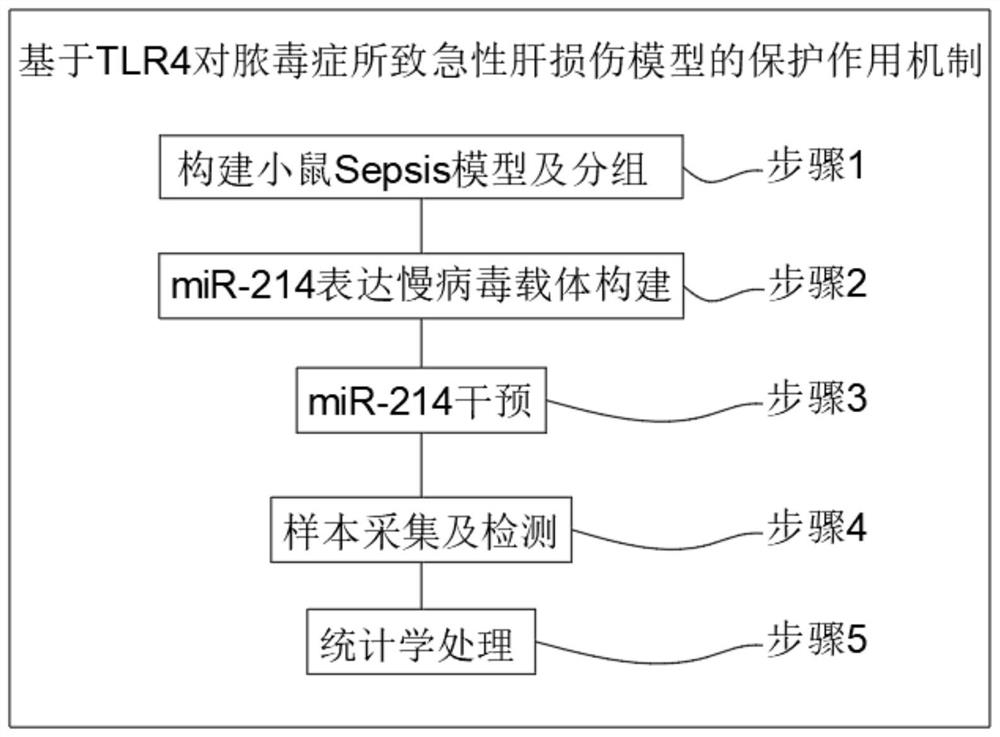TLR4-based protective action mechanism for acute liver injury model caused by sepsis
A technology for acute liver injury and protection, applied in the medical field, can solve the problem of acute liver injury without effective treatment measures, etc.
- Summary
- Abstract
- Description
- Claims
- Application Information
AI Technical Summary
Problems solved by technology
Method used
Image
Examples
Embodiment 1
[0053] see figure 1 , the present invention provides a technical solution: based on the protective mechanism of TLR4 on the acute liver injury model caused by sepsis, comprising the following steps:
[0054] Step 1: Construction of mouse Sepsis model and grouping;
[0055] Step 2: miR-214 expression lentiviral vector construction;
[0056] Step 3: miR-214 intervention;
[0057] Step 4: Sample collection and testing;
[0058] Step 5: Statistical processing.
[0059] The working principle and application process of the present invention: using the mouse model of liver injury caused by sepsis, observe the changes of serological indicators, inflammatory factors and pathological tissue of mice in each group of mice after miR-214 intervention, and the changes of liver tissue. miR-214 and TLR4 signaling pathway protein expression to explore the effect of regulating miR-214 expression on mice, whether miR-214 expression can inhibit TLR4 signal transduction pathway, block inflammat...
Embodiment 2
[0061] see Figure 1-2 , the present invention provides a technical solution: based on the protective mechanism of TLR4 on the acute liver injury model caused by sepsis, comprising the following steps:
[0062] Step 1: Construction of mouse Sepsis model and grouping;
[0063] Step 2: miR-214 expression lentiviral vector construction;
[0064] Step 3: miR-214 intervention;
[0065] Step 4: Sample collection and testing;
[0066] Step 5: Statistical processing.
[0067] In the present invention, preferably, step 1 includes the following steps:
[0068] Step 1.1: Adopt SPF grade C57BL / 6 mice, female, 13 weeks old, 80 mice, body weight 20-25g, rearing temperature is 22-25°C, indoor humidity is 35%-40%, and the breeding room is regularly sterilized by ultraviolet irradiation , fed according to the standard of laboratory mice, allowed to move freely, and the feeding time was 1 week;
[0069] Step 1.2: The selected 75 mice were randomly divided into normal group, sham operation...
Embodiment 3
[0081] see Figure 1-2 , the present invention provides a technical solution: based on the protective mechanism of TLR4 on the acute liver injury model caused by sepsis, comprising the following steps:
[0082] Step 1: Construction of mouse Sepsis model and grouping;
[0083] Step 2: miR-214 expression lentiviral vector construction;
[0084] Step 3: miR-214 intervention;
[0085] Step 4: Sample collection and testing;
[0086] Step 5: Statistical processing.
[0087] In the present invention, preferably, step 1 includes the following steps:
[0088] Step 1.1: Adopt SPF grade C57BL / 6 mice, female, 13 weeks old, 80 mice, body weight 20-25g, rearing temperature is 22-25°C, indoor humidity is 35%-40%, and the breeding room is regularly sterilized by ultraviolet irradiation , fed according to the standard of laboratory mice, allowed to move freely, and the feeding time was 1 week;
[0089] Step 1.2: The selected 75 mice were randomly divided into normal group, sham operation...
PUM
 Login to View More
Login to View More Abstract
Description
Claims
Application Information
 Login to View More
Login to View More - R&D
- Intellectual Property
- Life Sciences
- Materials
- Tech Scout
- Unparalleled Data Quality
- Higher Quality Content
- 60% Fewer Hallucinations
Browse by: Latest US Patents, China's latest patents, Technical Efficacy Thesaurus, Application Domain, Technology Topic, Popular Technical Reports.
© 2025 PatSnap. All rights reserved.Legal|Privacy policy|Modern Slavery Act Transparency Statement|Sitemap|About US| Contact US: help@patsnap.com


